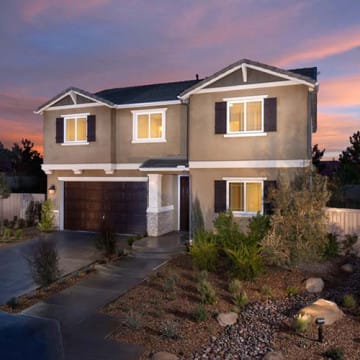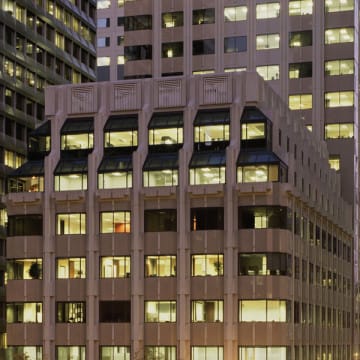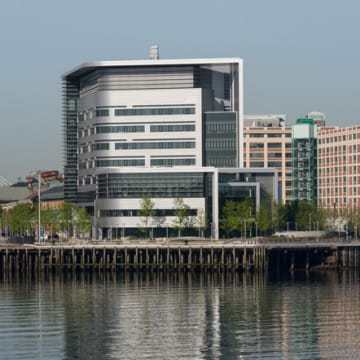Maceo May
Maceo May is a modular, all-electric affordable residential development being developed in San Francisco. Climate-responsive design contributes economic value for Maceo May’s owners and delivers a stable, healthy living environment for its residents, who are formerly homeless veterans and their families. Developed by two nonprofits, Chinatown Community Development Center and Swords to Plowshares, Maceo May will be the second all-electric affordable building in San Francisco. The $55 million development will be six stories tall with 105 units—24 studios, and 47 one-bedroom and 34 two-bedroom units—when construction is completed in 2022. The development is designed to be protected from sea level rise and to continue operations and remain safe and comfortable during periods of extreme heat, power outages, wildfire smoke, and seismic events.
Maceo May is the first building to go vertical as part of a master-planned redevelopment of Treasure Island, a 393-acre island in San Francisco Bay. The island will have all-new infrastructure, 8,000 new housing units, several commercial uses, and a considerable amount of open space. The U.S. Army Corps of Engineers constructed the island in the 1930s in part to celebrate the completion of the Bay Bridge and the Golden Gate Bridge. It hosted the World’s Fair in 1939–1940 and then a naval base, which was decommissioned in 1994.
Upon decommissioning, more than 200 units of military housing were set aside to serve as housing for the homeless and were managed by four organizations, including Swords to Plowshares, the co-owner of Maceo May. Thirty-nine resident households will move from that ex-military housing to Maceo May in spring 2022. The building will also have 65 apartments for veterans newly exiting homelessness.
The building’s resilient and sustainable features are essential for fulfilling the core purpose of the building—delivering stability, supportive services, and well-being for its residents. “Our desire to build resilience into this building was partly our values . . . and also a direct response to the current conditions on the island,” says Joanna Ladd, senior project manager and development strategist for Chinatown Community Development Center (Chinatown CDC). Power outages are a concern to residents currently living in the aging former military housing.
Swords to Plowshares and Chinatown CDC plan to own and operate Maceo May for at least 75 years, so the project team considered climate risk on that time horizon. “We were also thinking about the broader Northern California context, especially the catastrophic wildfire events in recent years, which coincided with public safety power shutoffs and hazardous air quality across the region,” says Hilary Noll, a project architect and senior associate and sustainability integration leader at Mithun. San Francisco’s air quality index reached 271 parts per million (ppm)—a “very unhealthy” level and the worst in San Francisco history—in November 2018 when the Camp Fire burned just north in Butte County.
Resilience Strategies
The design was guided by a set of outcome-based goals developed jointly by Mithun and the building owners. At the outset of the project, Chinatown CDC and Swords to Plowshares participated in a health charrette with Mithun that established continuity of operations and mitigation of climate change impacts on resident health as two key goals.
The Maceo May resilience approach also includes all-electric power (no natural gas), solar photovoltaic (PV) energy generation, and readiness for net-zero carbon operations as the California grid continues to meet carbon-reduction targets. Maceo May also features passive design strategies and backup power. Natural gas is a vulnerable infrastructure asset in San Francisco because earthquakes can damage gas infrastructure and lead to explosions and methane leaks, Noll notes.
Net-zero capable, Maceo May is designed to maximize energy efficiency with an energy use intensity (EUI) about 70 percent lower than an average multifamily building in the United States. Air-source heat pumps provide hot water four to five times more efficiently than does a typical boiler. A high-performance building envelope that incorporates 1.5 inches of rigid-mineral-wool continuous insulation minimizes heating and cooling loads, allowing smaller residential heating equipment and cutting costs. Occupancy sensors and daylight dimmers also limit electricity use
All Maceo May’s resilient design strategies come back to clear health and quality-of-life benefits for residents.—Joanna Ladd, senior project manager and development strategist, Chinatown Community Development Center
The development team also chose to install an energy recovery ventilator (ERV) with a MERV 13 filter for every residential unit. The ERV reduces HVAC electricity consumption, and the MERV 13 filter exceeds conventional practice and will help filter particulate matter and airborne debris to maintain better indoor air quality, which is a considerable concern during wildfire events and heat waves.
“Given that Treasure Island will be under construction for a long time after the building opens and that we’re housing a population who bears disproportionate health issues such as compromised immune systems and other effects from having endured trauma, designing for good indoor air quality is paramount,” says Noll.
Passive design strategies and superior ventilation also limit energy use, create good air quality, and support the thermal comfort of residents, especially during potential power outages. Maceo May is oriented to take advantage of San Francisco Bay breezes. Windows are operable and have a low u-value of 0.34 and solar-heat gain resistance of 0.19; double-pane low-E glazing is argon filled (indicating a high level of insulation and resistance to heat transfer). South- and west-facing windows are shaded. In residential units, ceiling fans and operable windows located at different heights maximize airflow.
A rooftop 123-kilowatt solar PV array with on-site battery storage is designed to prioritize powering a first-floor community room that doubles as a “resilience hub.” Inverters link the array to both battery storage and the local grid so Maceo May has the ability to be self-sustaining. The battery backup system is located on the top floor to prevent problems in the event of flooding.
The setup powers critical building systems that support resident well-being, such as refrigeration (for storing essential daily medications), basic power and light (including for charging devices), and cooling for data and wi-fi closets that are specifically circuited for the ground-floor community space. The resilience hub’s operability during power outages is a means of minimizing disruption in residents’ lives, a key resilience goal in a home for veterans.
During eco-charrette discussions with the owners, we learned that many of the residents suffer from PTSD [post-traumatic stress disorder] symptoms. One of the best evidence-based design strategies to help someone with PTSD to heal is to create conditions of continuity in daily life.—Hilary Noll, architect, Mithun
Maceo May will also include sustainability and health and wellness amenities such as electric-vehicle parking, bicycle storage and repair, a forested healing garden, a playground and cookout area, and access to an adjacent community park and planned trail network.
Value Proposition
According to developer Ladd, the big takeaway is that “all-electric multifamily affordable housing is cost neutral at a minimum.” Going all-electric did not significantly increase costs, the design helped avoid some infrastructure expenses, and utility bills are expected to be much lower than for a typical multifamily building once the solar PV array is installed. Construction costs, which are bid out at $472 per square foot, are on the high end but not far outside the normal range for San Francisco.
Tax credits for efficiency
The financing for Maceo May is characteristic of affordable housing in California, benefiting from tax credits and tax-exempt bonds. Passive design and heat pumps (which cost more to install than conventional options) helped Maceo May qualify for federal tax credits provided to energy-efficient affordable housing. The development also received critical funding from the state’s Veterans Housing and Homelessness Prevention (VHHP) Program.
Avoided costs and operational savings
“Eliminating natural gas has an immediate co-benefit,” says Noll; the project will save about $250,000 by avoiding equipment such as gas piping, meters, and combustion venting. Another significant area of savings came from the Cadet heater units, which eliminate the need for the copper piping in typical hydronic baseboard systems. The money realized by the avoided costs was reinvested in the project via the installation of the ERV (a $1,200-per-unit cost premium over a conventional Z-Duct heat exchanger) and the resilience hub, an added cost of about $100,000.
Our efficient all-electric building and large solar array are an insurance policy against rising utility costs over time, which is huge for affordable housing developers with small reserves and operating budgets. —Joanna Ladd, senior project manager and development strategist, Chinatown Community Development Center
Future-proofing
By already meeting stringent energy efficiency and sustainability standards, Maceo May is positioned to adjust to any future legislation that increases minimum energy and sustainability requirements. California’s goal is zero net emissions by 2045, and the Berkeley City Council voted in summer 2019 to ban natural gas connections to new small and medium-sized residential buildings. Five other cities and counties in California are considering similar ordinances, and the Maceo May development team expects San Francisco to follow with a gas ban in the near future.
The development team also describes the solar PV array as insurance against potential rising utility costs. The solar PV array mitigates the risk of going all-electric before the co-owners have a wealth of building performance and benchmarking data on air-source heat pump hot water systems from Maceo May and other developments in the region. The solar array is designed to cover about 80 percent of the common-area loads of the building, which could be a long-term economic resilience boost to the owners.
Awards and public support
Maceo May is pursuing Fitwel certification and is on track to earn GreenPoint Gold. It is also a pilot project for the LEED Integrative Process for Health Promotion credit, a category the U.S. Green Building Council (USGBC) and the Green Health Partnership introduced in 2019. The city of San Francisco was also supportive of the development, making the approval process efficient and relatively easy. The city is committed to making municipal buildings all-electric and was eager to learn from the experience of developing Maceo May, especially because the project costs were within a normal range.
Lessons Learned
- All-electric affordable housing in California can be cost neutral to build.
- The cost of resilience features can be offset through savings from sustainability measures.
- Engagement between the building owner and design team in setting outcome-based design goals preserved essential design features, saved time through the process, and illuminated opportunities to achieve co-benefits.


